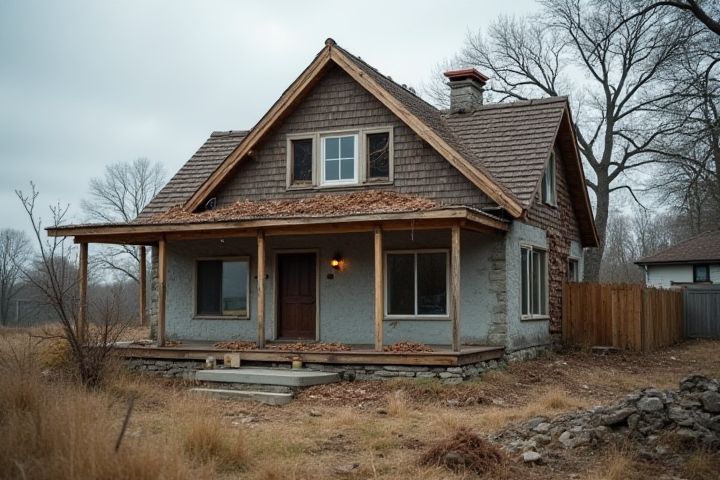
Strengthening your home's structure can significantly enhance its resilience against natural disasters. First, consider retrofitting your home with reinforced materials like steel frames or concrete blocks to better withstand earthquakes and high winds. Installing storm shutters and impact-resistant windows is essential for safeguarding against hurricanes and severe storms, while elevated foundations can help prevent flooding in flood-prone areas. You should also create a defensible space around your property through landscaping techniques that minimize fire risk, such as maintaining a clear zone of vegetation. Finally, developing an emergency plan and securing essential supplies will prepare you and your family to respond effectively during a disaster.
How To Protect A House From Natural Disasters
Strengthen roof structures
Strengthening roof structures is crucial for protecting your home from natural disasters such as hurricanes, tornadoes, and heavy snowfall. Consider reinforcing the roof with hurricane straps, which connect the roof to the walls, enhancing resistance against high winds. Opt for durable materials like metal or impact-resistant shingles to increase longevity and resilience. Regular maintenance, including clearing gutters and inspecting for damage, helps ensure your roof remains robust during extreme weather events.
Install storm shutters
Installing storm shutters is a proactive measure to protect your home from severe weather phenomena such as hurricanes and heavy storms. These durable barriers can significantly reduce wind and debris damage to windows and doors, which are often the most vulnerable points of entry. Made from materials like aluminum or polycarbonate, storm shutters can be permanently mounted or deployed as needed, depending on your specific needs and climate. By investing in high-quality storm shutters, you ensure your property remains secure and minimizes costly repairs after a natural disaster.
Use impact-resistant windows
Using impact-resistant windows is an essential strategy to safeguard your home against natural disasters, particularly hurricanes and severe storms. These windows are engineered to withstand extreme winds and flying debris, significantly reducing the risk of breakage. Unlike standard glass, impact-resistant options often consist of laminated glass that can endure winds exceeding 130 miles per hour. Investing in these windows not only protects your home but can also lead to reduced insurance premiums, enhancing your overall property value.
Elevate utilities and appliances
Elevate utilities such as water heaters, furnaces, and electrical panels above anticipated flood levels to reduce the risk of damage during natural disasters like flooding. Installing these essential appliances on platforms or in upper stories can significantly improve your home's resilience. Ensure that venting systems and ducts are also raised to prevent water infiltration, which can lead to costly repairs and hazardous mold growth. By taking these proactive steps, you create a safer living environment for yourself and your family in the face of potential natural threats.
Seal windows and doors
Sealing windows and doors effectively reduces the risk of water and wind damage during natural disasters, such as hurricanes and floods. Use weatherstripping or caulking to fill any gaps, ensuring a tight seal that can withstand high-pressure winds; this can save you approximately 10-20% on energy costs as well. Consider installing impact-resistant windows and doors, which can withstand debris and extreme weather conditions, providing an added layer of protection. Regularly inspect and maintain these seals, as wear and aging can lead to vulnerabilities that compromise your home's safety during emergencies.
Reinforce garage doors
Reinforcing garage doors can significantly enhance your home's resilience against natural disasters, particularly strong winds from hurricanes or tornadoes. The use of sturdy materials, such as impact-resistant steel or fiberglass, can increase the door's strength; for instance, an upgrade to a door rated for winds of up to 140 mph can provide peace of mind. Installing horizontal and vertical supports along the door's frame can also prevent deformation during severe weather events. Regular maintenance, including checking for wear and tear, ensures your garage door remains a reliable barrier against external threats.
Maintain proper drainage systems
Maintaining proper drainage systems is crucial for protecting your house from natural disasters such as floods and heavy storms. Ensure that gutters and downspouts are clear of debris, directing water at least 10 feet away from your foundation. Installing a French drain or a sump pump can effectively reduce water pooling around your home, minimizing the risk of water damage. Regularly inspecting your drainage system and making necessary adjustments can safeguard your property, reducing repair costs that could otherwise reach thousands of dollars.
Secure outdoor items
Secure outdoor items by anchoring them to prevent wind from causing damage during storms; use heavy-duty straps or anchors for larger furniture. Store smaller items like potted plants, patio furniture, and grilling equipment indoors or in a sturdy shed to minimize hazards. Utilize garage space effectively, designating areas for outdoor tools and toys, ensuring they are out of the elements. Consider investing in storm-resistant storage solutions designed to withstand high winds and heavy rainfall, enhancing your home's disaster preparedness.
Retrofit foundation
Retrofitting your foundation is a crucial step in safeguarding your home against natural disasters like earthquakes and floods. Strengthening the connection between your foundation and the home's structure can significantly reduce the risk of damage during seismic activity. Techniques such as bolting the sill plate to the foundation, adding shear walls, and installing piers or underpinning can enhance stability and resilience. Regularly inspecting and maintaining your retrofitted foundation ensures ongoing protection and compliance with local building codes.
Create a defensible space
Creating a defensible space around your house is crucial for minimizing damage during natural disasters such as wildfires. Aim for a minimum clearance of 30 feet between your home and any vegetation; this space should be kept free of dead plants and debris. Consider using fire-resistant landscaping materials, like gravel or stone, to further reduce fire risk within this zone. Ideally, maintain a well-watered lawn and prune trees to prevent flammable branches from touching your home, ensuring your property is better protected against fire hazards.
